_600.webp) |
| At the bar with Nocturama director Bertrand Bonello Photo: Anne-Katrin Titze |
After being seated next to Django director Étienne Comar and Reda Kateb (who portrays Django Reinhardt) at the uniFrance Locanda Verde lunch, I had a conversation with Bertrand Bonello on his latest film. Nocturama, shot by cinematographer Léo Hinstin, edited by Fabrice Rouaud, costumes by Sonia Philouze with music by Bonello. It has an ensemble cast that includes Finnegan Oldfield, Vincent Rottiers, Hamza Meziani, Manal Issa, Martin Petit-Guyot, Jamil McCraven, Rabah Nait Oufella, Laure Valentinelli, Ilias Le Doré, Robin Goldbronn, Luis Rego, Hermine Karagheuz, and Adèle Haenel.
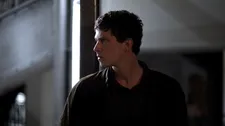 |
| Finnegan Oldfield as David in Nocturama Photo: Carole Bethuel |
When I spoke last year with Thomas Bidegain on Les Cowboys about actor Finnegan Oldfield, who stars in both his and Bertrand's film, he told me that Nocturama was being edited the day of the Bataclan attack in Paris.
Nocturama, a highlight of New York's Rendez-Vous with French Cinema, begins with helicopter noises - Paris feels under siege from the start. Romantic notions that so often accompany establishing shots of this city are drained from the get-go. This is a thriller about a massive attack, shouldered by a group of millennial militants of different cultural backgrounds. As we follow them through the Paris Métro, on the streets, into official and private buildings, as they synchronise the time every now and then, the vulnerability of urban living is accentuated in every step they take.
It is in the second half of Nocturama - which takes place in a department store by night - that Bertrand Bonello's prowess of showing us worlds closing in on themselves comes to full force. And the world in question this time around is not the French high fashion industry of the 1970s or a brothel at the turn of the last century - it is our world, right here, right now.
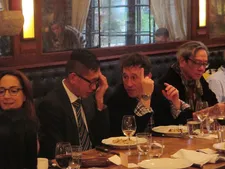 |
| Bertrand Bonello makes a point to Dennis Lim at the uniFrance lunch Photo: Anne-Katrin Titze |
Adèle Haenel who has a cameo as an unnamed citizen on a bike, diagnoses that an attack "was bound to happen" sooner or later. If the detailed mechanics of the plotting were part of a French Resistance maneuver during the Second World War, we'd be impressed by their ingenuity.
The old-fashioned childhood dream of being locked up in a toy store to play to your heart's content is so cleverly used, that it turns into its own nightmare that eats up its kids. Packing a whole life in one night in one place is what movies have set as an objective before. Nocturama makes it terrifyingly clear that saying "help me" is not the same as "help us."
Anne-Katrin Titze: The structure of your film is great. Who just cuts their film in half? And the two separate entities so much inform each other. Where did that idea come from?
Bertrand Bonello: It's very difficult to know where ideas come from. They just arrive sometimes. But the structure was very likely the beginning of the film. The idea of the film was the structure. I wanted to do a film in two parts. One by day, one by night. One exterior, one interior. One in the real world and one in this really fake world of the mall. One with people isolated in movement and the second one, people together but stopped.
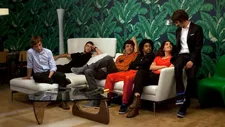 |
| "I wanted to do a film in two parts. One by day, one by night. One exterior, one interior." Photo: Carole Bethuel |
AKT: Stopped?
BB: Yeah, the time stops in a way when they arrive in the mall. So the basis of the film was the structure in fact.
AKT: When you were here for Saint Laurent during the New York Film Festival, I asked you about the conference room scene and you said you wanted to stage it like a battle. Do you like to combine things that might seem non-compatible but actually are?
BB: I like the idea to take one thing and another and when you put them together it creates a third thing. For me, it's like the most beautiful thing in cinema is the editing. You take a normal image and another image and when you put them together it creates something. It's something I like to work on. I like more and more the idea of contrast also. Not only having one note but different notes that contrast and make strange music.
AKT: When I spoke to Thomas Bidegain about Finnegan Oldfield - who is in both his and your film - he said that you were in the editing process right when the Bataclan attack happened.
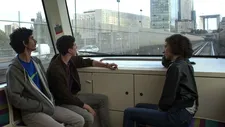 |
| "One with people isolated in movement and the second one, people together but stopped." Photo: Carole Bethuel |
BB: Yes. I finished the first cut just before the Bataclan. So, of course, it was very weird to go back into the editing room just after. So I took a few days off. And then I showed the film to my producers and distributors and sellers just to discuss what we're going to do afterwards, you know. And we decided to continue the film. It was almost finished in a way. It was a very weird moment.
AKT: Did the moment with Adèle Haenel come after or before? Was she added?
BB: No, no everything was written before that.
AKT: She is you in a way, no?
BB: Yeah. It's me talking through her. But the film was almost finished at that time.
AKT: You felt that there was something in the air?
BB: I wrote the film in 2011 and it's something I could feel very strongly in the air. It's just an intuition, a sensation. Of course I wouldn't say this is going to happen because of this or that. These people come from here or there. It's just a feeling you have when you go in the street, the Métro, the bars, the cafés. When you open the newspaper, you say something is so tense that it is going to explode.
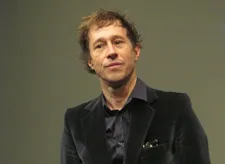 |
| Bertrand Bonello when he presented Saint Laurent at the New York Film Festival Photo: Anne-Katrin Titze |
AKT: Nocturama is at its core about young people not having really anything to live for.
BB: Yeah.
AKT: During the first part, I thought, if this were the Resistance, if you placed these actions during the Second World War, we would cheer them on.
BB: But the time has passed.
AKT: Totally different.
BB: The main subject is much more about the youth than about terrorism. The film has nothing to do with today's terrorism. It's more about an emptiness, a very strong emptiness of the young people.
AKT: Do you think it has to do with technology? The type of access to experience?
BB: It's not only that but it's part of it.
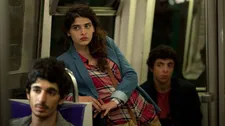 |
| "I like the idea to take one thing and another and when you put them together it creates a third thing." Photo: Carole Bethuel |
AKT: Everything seems to be there for the taking - which is what you do with the department store. It's a childhood dream to be locked in a department store and you can go and play.
BB: That's what everybody says. Oh, I'd love to be alone there one night.
AKT: Trying on all the Isabel Marant clothes and Fendi coats and bathtubs?
BB: At the same time it's something very freaky. It's like a golden prison and it's not…
AKT: A golden prison?
BB: They sell you this as a perfect world but it's a world that destroys you. That's a kind of paradox.
AKT: In your film you add the element of time to it. It turns out that these characters have to live their whole life in one night. Time becomes really important.
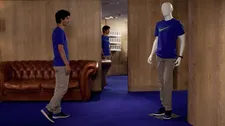 |
| "Yeah, the time stops in a way when they arrive in the mall." Photo: Carole Bethuel |
BB: Exactly. While I was writing, my main obsession was how to deal with time in the film. There's two parts but in a way there are three acts. In the first act the relationship with time is precision and simultaneous time. In the second act, in a way, time stops; they have to wait. And the third time is when the police arrives, time is really fucked up. So it's three very precise and different relationships with time put into the acts.
AKT: What is coming up for you next?
BB: I just take notes for the moment. I'm not sure. It's very difficult for me after this film to go straightaway to another project. It's a quite special project this one and I think I need a little break. I've done a lot in the last five or six years and I don't want to just make one movie after another. I need time.
AKT: I was struck by some of the connections I felt between your films. The prostitutes trapped in 1910 in House Of Tolerance and the teenagers trapped in the department store of Nocturama.
BB: There are some relationships between the films. The very, very big difference is that in the House of Tolerance, of course the prostitutes are quickly victims. In this one, it's more complicated to say are they victims or are they not. Are they on the good side or the bad side? It's more complicated. But otherwise there are relationships between the two films.
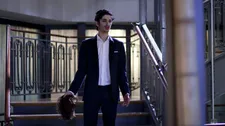 |
| "It's more about an emptiness, a very strong emptiness of the young people." Photo: Carole Bethuel |
AKT: Last question. The last line in the film is "Help me!" That's totally different than Help us!
BB: Ah. But I have to say, at that moment, the guy feels really alone. Yeah, I never thought of that. You're right. But he is alone and it's a scream to, of course, the police, but in a wider sense to the world, in fact.
AKT: It is a political scream.
BB: At that moment, he is lost. And maybe he doesn't know why he did all of this. That he had no choice.
AKT: And then in our heads we can connect it back to Blondie singing "call me any, any time?"
BB: Yeah.
The uniFrance and Film Society of Lincoln Center's 22nd edition of Rendez-Vous with French Cinema in New York, runs through March 12. Screenings will take place at the Walter Reade Theater, Lincoln Center.





















